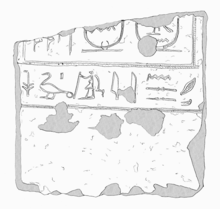Yanassi
Yanassi was a prince during the Fifteenth Dynasty. He was the eldest king's son of the Hyksos pharaoh Khyan and this title suggests that he was the crown prince, designated to be his successor. Nevertheless, Khyan was succeeded by Apophis who, for this reason, is believed to have been an usurper.[1]:256

Attestations
In spite of his status as the royal son of the long-reigning Khyan, Yanassi is not attested by any scarab seals but only by a damaged stela (Cairo TD-8422 [176]) found at Tell el-Dab'a, site of the ancient Hyksos capital, Avaris.[2][1]:57 n.159 On the stela – which was probably dedicated to the god Seth, lord of Avaris – he is called the eldest king's son of Khyan.[1]:256
Ptolemaic Greek Tradition
A further, though non-contemporary attestation may be found in Josephus' polemic, Contra Apionem. Claiming to directly quote Manetho, Josephus put a king named Iannas instead of Siaan (the latter being a Greek form of the name Khyan) within the 15th Dynasty, ascribing to him a reign lasting for 51 years and one month.[3][1]:120–21 It has been suggested that the name Iannas (Ancient Greek: Iαννας) is a corruption of Yanassi. If true, this means that Manetho would have considered Yanassi as a king, a statement refuted by modern consensus which considers Apophis as Khyan's direct successor. It appears more likely that, in a Manethonian passage mentioning both Iannas/Yanassi and Siaan/Khyan, Josephus erroneously chose the former instead of the latter.[1]:120–21
References
- Ryholt, Kim (1997). The Political Situation in Egypt during the Second Intermediate Period, c.1800-1550 BC. Copenhagen: Museum Tusculanum Press.
- Bietak, Manfred (1981). "Eine Stele des ältesten Königssohnes des Hyksos Chajan". Mitteilungen des Deutschen Archäologischen Instituts, Abteilung Kairo (MDAIK). 37: 63–73.
- Gardiner, Alan (1961). Egypt of the Pharaohs: an introduction. Oxford University Press. p. 156.
Further reading
- Hein, I., ed. (1994). Pharaonen und Fremde - Dynastien im Dunkeln. Vienna. pp. 155–56, No. 133.